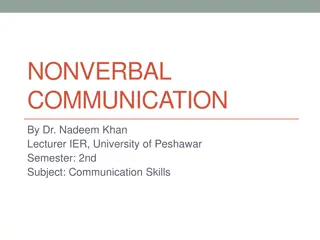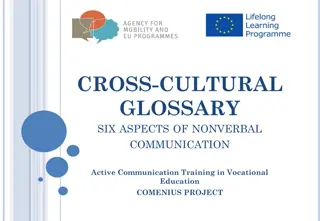Exploring Silent Languages: Sign Language, Body Language, and Nonverbal Communication
Delve into the world of silent languages through an introduction to linguistic anthropology in Chapter 5. Explore the transmission of messages without spoken words, the intricacies of sign languages, gestures, body language, and nonverbal communication. Discover the unique syntax and complexity of sign languages like American Sign Language (ASL) and the role of paralanguage in communication. Gain insights into the cultural interpretations of body language, the nuances of smell, taste, and touch, as well as the significance of proxemics in spatial interactions.
Download Presentation

Please find below an Image/Link to download the presentation.
The content on the website is provided AS IS for your information and personal use only. It may not be sold, licensed, or shared on other websites without obtaining consent from the author. Download presentation by click this link. If you encounter any issues during the download, it is possible that the publisher has removed the file from their server.
E N D
Presentation Transcript
The Anthropology of Language: An Introduction to Linguistic Anthropology Chapter 5 Silent Languages 1
The transmission of messages w/o spoken word Sign languages analyzing signs Gestures and nonverbal communication Speech substitutes Body language Smell, Taste, Touch Proxemics & Kinesics gender, status, culture & space types of gestures Gesture systems 2
Sign language IS language Language performed in three-dimensional space Generally associated with deaf people Often associated with Deaf people Natural vs. Manually Coded sign languages Syntax is complex, unique to specific language American Sign Language (ASL; Ameslan) vs. British Mutually unintelligible; not based on English syntax Signs = concepts, not words ( right vs. right ) Syntax = one sign can stand for several words E.g., I-ask-her is one sign vs. Signed English (SEE1 & 2) which follows English syntax 3
Analyzing Signs Primes Basic elements of signs (correspond to phonemes?) Combine into morphemes Three kinds of primes Hand shape Fist (A), Flat (B), Cupped (C) Hand placement Hand movement Minimal pairs Apple vs. candy (shape: fist hand vs. cupped hand) Summer vs. ugly (place: forehead vs. nose level) 4
Sign language is NOT gesture View this ASL example Can you separate the gesture from the sign? What elements of paralanguage play a key role in this performance? Note the gender shift as the performer moves from his pre-performance self to the performance self Men typically perform signs lower than women 5
Body Language Learned in cultural groups Interpreted unconsciously Often overrides verbal language ~60% of communication? Beware of guidebooks. 6
Smell, Taste, and Touch Smell And ethnicity, culture Cigars, perfumes and status Taste And group membership Spicy foods Touch And gender and power Relation to proxemics 7
Proxemics Edward Hall, 1950s How people perceive and use space Cowboy proxemics Getting to theatre seats 8
Gender, Status, & Space Entering into someone s space Getting the best office Or the biggest bedroom Having one s own space Dens vs. sewing rooms 9
Culture and Space Different arrangements US grids & French circles German doors: closed vs. open Different uses Where to eat in the Comoros Depends on gender, too 10
Kinesics meaningful movement (Birdwhistell) Kineme with allokines Kinemorphs meaningful units of visual expression Later, kinemorphs abandoned as a concept, kineme comes to mean both the minimal and the meaningful units. 11
Kinesics another model of meaningful movement (Ekman and Friesen) Emblems direct verbal translation Illustrators depict or illustrate what is being said Affect displays convey emotion Regulators control or coordinate interaction, for example indicating that it is someone s turn to talk Adaptors expressions of restlessness or unease, facilitate the release of tension 12
Gesture Systems Where verbal communication is difficult Topics and contexts are limited Simple alternative systems Little or no syntax Sawmills, baseball games, sailboat racing Complex alternative systems Syntax based on spoken language: Australian women mourners Some monastic orders Syntax independent of any spoken language Native American Plains sign language Signs used in varying order 13
Typology of Gestures Eckman & Friesen, 1960s Emblems Translatable (waving) Illustrators Of what is said (steering) Affect Displays Convey emotion (smiling) Regulators Control or coordinate (pointing) Adaptors Facilitate release (wiggling) 14
Gesture Systems Where verbal communication is difficult Topics and contexts are limited Simple alternative systems Little or no syntax Sawmills, baseball games, sailboat racing Complex alternative systems Syntax based on spoken language: Australian women mourners Some monastic orders Syntax independent of any spoken language Native American Plains sign language Signs used in varying order 15
Speech Substitutes Sound signals substitute for spoken words Or parts of words Useful for communicating over distances Examples: Drum languages based on tones (Nigeria) Whistle languages based on tones (Mazateco) based on vowels (La Gomera) different whistled pitches = different vowels 16
Speech substitutes Present only parts of words, listeners fill in the blanks. Stereotyped and predictable. How are these different from ASL? ASL is a language, NOT a speech substitute! How are ASL and SEE different? 17
Filling in the blanks Yoruba talking drums Use of a talk-box, from the Master 18
Creating a Language Create a proxemic system define degrees of space: private, personal, social & public Create two or three gestures: friendly, obscene, teasing, aggressive, etc. Practice! Use your greetings and proxemics rules, try out your gestures. 19
Next: Language in Action Read: Textbook Chapter 6 Workbook/Reader: Good Tracks (pp. 121-126) Prepare to do: Writing/Discussion Exercises (W/R p. 127-130) Practice with Languages (W/R pp. 131-132) Language Creating (W/R p. 135) Conversation partnering (W/R p. 136) 20























